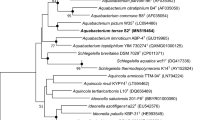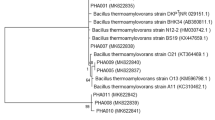Abstract
A new isolate designated as strain EB172 was isolated from a digester treating palm oil mill effluent and was investigated by polyphasic taxonomic approach. The cells were rod-shaped, Gram-negative, non-pigmented, non-spore-forming and non-fermentative. Phylogenetic analysis using the 16S rRNA gene sequence showed that the strain clustered with the genus Comamonas. Its closest neighbours were the type strains Comamonas terrigena (96.8%), Comamonas koreensis (93.4%), Comamonas composti (92.9%), and Comamonas kerstersii (91.1%). The ability of the strain EB172 to produce polyhydroxyalkanoates (PHA) when supplied with organic acids made this bacterium unique among Comamonas species. The bacterial strain was clearly distinguished from all of the existing strains by phylogenetic analysis, fatty acid composition and a range of physiological and biochemical characteristics. The G+C content of the genomic DNA was 59.1 mol%. The strain showed good growth in acetic, propionic and n-butyric acids. Comamonas sp. EB172 produced 9.8 g/l of cell dry weight and accumulated 59 (wt%) of PHAs when supplemented with mixed organic acids from anaerobically treated palm oil mill effluent. It is evident from the genotypic, phenotypic data and ability to produce PHAs that strain EB172 represents a new strain in the genus Comamonas (GeneBank accession no. EU847238).





Similar content being viewed by others
References
Altschul SF, Madden TL, Schaffer AA, Zhang J, Zhang Z, Miller W, Lipman DJ (1997) Gapped blast and psi-blast: a new generation of protein database search programs. Nucleic Acids Res 25:3389–3402
Braunegg G, Sonnleitner B, Laffer RM (1978) A rapid gas chromatographic method for the determination of polyβ-hydroxyalkanoates acid in microbial biomass. Eur J Appl Microbiol Biotechnol 6:29–37
Chang Y-H, Han J-i, Chun J, Lee KC, Rhee M-S, Kim Y-B, Bae KS (2002) Comamonas koreensis sp. nov., a non-motile species from wetland in Woopo, Korea. Int J Syst Evol Microbiol 52:377–381
Chong ML, Raha AR, Shirai Y, Hassan MA (2009) Biohydrogen production by Clostridium butyricum EB6 from palm oil mill effluent. Int J Hydrogen Energy 34:764–771
Cole RM, Popkin TJ (1981) Electron microscopy. In: Gerhart P, Murray RGE, Costilaw RN, Nester EW, Wood WA, Krieg NR, Phillips GB (eds) Manual of methods for general bacteriology. Washington DC, pp, pp 34–51
Doi Y (1990) Microbial Polyesters. VCH publishers, NY
Grothe E, Moo-Young M, Chisti Y (1999) Fermentation optimization for the production of poly(β-hydroxybutyric acid) microbial thermoplastics. Enzyme Microb Technol 25:132–141
Gumaelius L, Magnusson G, Pettersson B, Dalhammar G (2001) Comamonas denitrificans sp. nov., an efficient denitrifying bacterium isolated from activated sludge. Int J Syst Evol Microbiol 51:999–1006
Hassan MA, Shirai Y, Umeki H, Yamazumi H, Jin S, Yamamoto S, Abdul Karim MI, Nakanishi I, Hashimoto K (1997) Acetic acid separation from anaerobically treated palm oil mill effluent by ion exchange resins for the production of polyhydroxyalkanoate by Alcaligens eutrophus. Biosci Biotech Biochem 61:1465–1468
Hassan MA, Nawata O, Shirai Y, Nor `Aini AR, Phang LY, Ariff A, Abdul Karim MI (2002) A proposal for zero emission from palm oil industry incorporating the production of poluhydroxyalkanoates from palm oil mill effluent. J Chem Eng Japan 35:9–14
Kim JH, Kim BG, Choi CY (1992) Effect of propionic acid on poly(β-hydroxybutyric-co-β-hydroxyvaleric) acid production by Alcaligenes euthrophus. Biotechnol Lett 14:903–906
Kimura M (1980) A simple method for estimating evolutionary rates of base substitutions through comparative studies of nucleotide sequences. J Mol Evol 16:111–120
Kobayashi G, Tanaka K, Itoh H, Tsuge T, Sonomoto Ishizaki A (2000) Fermentative production of P(3HB-co-3HV) from propionic acid by Alcaligenes euthrophus in fed-batch culture with pH-stat continuous substrate feeding method. Biotechnol Lett 22:1067–1069
Kumar S, Tamura K, Nei M (2004) MEGA 3: Integrated software for molecular evolutionary genetics analysis and sequence alignment. Brief Bioinfo 2:150–163
Lee IY, Kim MK, Chang HN, Park YH (1994) Effect of propionate on accumulation of poly(β-hydroxybutyrate-co-β-hydroxyvalerate) and excretion of pyruvate in Alcaligenes euthrophus. Biotechnol Lett 16:611–616
Maidak BL, Cole JR, Parker CTJ, Garrity GM, Larsen N, Li B, Lilburn TG, McCaughey MJ, Olsen GJ, Overbeek R, Pramanik S, Schmidt TM, Tiedje JM, Woese CR (1999) A new version of the RDP (ribosomal database project). Nucleic Acids Res 27:171–173
Mesbah M, Premachandran U, Whitman WB (1989) Precise measurement of the G+C content of deoxyribonucleic acid by high performance liquid chromatography. Int J Syst Bacteriol 39:159–167
Ostle AG, Holt JG (1982) Nile Blue A as a fluorescent stain for poly(3-hydroxybutyrate). Appl Environ Microbiol 44:238–241
Powers EM (1995) Efficacy of the Ryu non-staining KOH technique for rapidly determining gram reactions of food- borne and waterborne bacteria and yeasts. Appl Environ Microbiol 61:3756–3758
Rahayu A, Zaleha Z, Yahya ARM, Majid MIA, Amirul AAA (2008) Production of copolymer poly(3-hydroxybutyrate-co-4-hydroxybutyrate) through a one-step cultivation process. World J Microbiol Biotechnol 24:2403–2409
Saitou N, Nei M (1987) The neighbor-joining method: a new method for reconstructing phylogenetic trees. Mol Biol Evol 4:406–425
Stackebrandt E, Goebel BM (1994) Taxonomic note: a place for DNA-DNA reassociation and 16S rRNA sequence analysis in the present species definition in bacteriology. Int J Syst Bacteriol 44:846–849
Sugimoto T, Tsuge T, Tanaka K, Ishizaki A (1999) Control of acetic acid concentration by pH-stat continuous substrate feeding in heterotrophic culture phase of two-stage cultivation of Alcaligenes euthrophus for production of P(3HB) from CO2, H2, and O2. Biotechnol Bioeng 62:625–631
Tabassum M, Suraini AA, Nor `Aini AR, Phang LY, Shirai Y, Hassan MA (2008) Pilot-scale recovery of low molecular weight organic acids from anaerobically treated palm oil mill effluent (POME) with energy integrated system. Afr J Biotechnol 21:3900–3905
Thakor NS, Patel MA, Trivedi UB, Patel KC (2003) Production of poly(β-hydroxybutyrate) by Comamonas testosteronii during growth on naphthalene. World J Microbiol Biotech 19:185–189
Wauters G, De Baere T, Willems A, Falsen E, Vaneechoutte M (2003) Description of Comamonas aquatica comb. nov. and Comamonas kerstersii sp. nov. for two subgroups of Comamonas terrigena and emended description of Comamonas terrigena. Int J Syst Evol Microbiol 53:859–862
Wayne LG, Brenner DJ, Colwell RR, Grimont PAD, Kandler O, Krichevsky MI, Moore LH, Moore WEC, Murray RGE, other authors (1987) International committee on systematic bacteriology. Report of the ad-hoc committee on reconciliation of approaches to bacterial systematics. Int J Syst Bacteriol 37:463–464
Yacob S, Shirai Y, Hassan MA, Minato W, Sunderaj S (2006) Start-up operation of semi-commercial closed anaerobic digester for palm oil mill effluent treatment. Process Biochem 41:962–964
Young C-C, Chou J-H, Arun AB, Yen W-S, Sheu S-Y, Shen F-T, Lai W-A, Rekha PD, Chen W-M (2008) Comamonas composti sp. nov., isolated from food waste compost. Int J Syst Evol Microbiol 58:251–256
Zakaria MR, Abd-Aziz S, Ariffin H, Nor `Aini AR, Phang LY, Hassan MA (2008) Comamonas sp. EB172 isolated from digester treating palm oil mill effluent as potential polyhydroxyalkanoate (PHA) producer. Afr J Biotechnol 22:4118–4121
Acknowledgments
The authors would like to acknowledge the Federal Land Development Authority, Malaysia (FELDA), Japan Society for Promotion of Science (JSPS) and Ministry of Science Technology and Innovation, Malaysia (MOSTI) for funding and technical support during the study period.
Author information
Authors and Affiliations
Corresponding author
Rights and permissions
About this article
Cite this article
Zakaria, M.R., Tabatabaei, M., Ghazali, F.M. et al. Polyhydroxyalkanoate production from anaerobically treated palm oil mill effluent by new bacterial strain Comamonas sp. EB172. World J Microbiol Biotechnol 26, 767–774 (2010). https://doi.org/10.1007/s11274-009-0232-y
Received:
Accepted:
Published:
Issue Date:
DOI: https://doi.org/10.1007/s11274-009-0232-y




